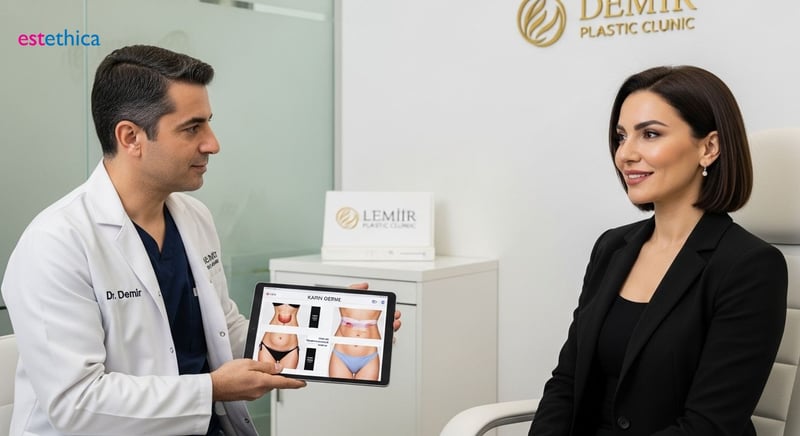Tummy Tuck Transformation: Reveal Your Ideal Silhouette
Learn about tummy tuck (abdominoplasty) procedures, recovery, candidacy, and costs to achieve your ideal abdominal silhouette with plastic surgery.
Abdominoplasty Explained: What to Expect
Understanding the Abdominoplasty Procedure
Abdominoplasty, commonly referred to as a tummy tuck, is a sophisticated surgical procedure performed by qualified plastic surgeons to significantly improve the aesthetic appearance of the abdomen. It is designed to address concerns such as excess, loose skin and stubborn fat deposits in the middle and lower abdominal regions. Furthermore, it tightens the underlying muscles of the abdominal wall, which may have become weakened or separated over time, for instance, due to pregnancy or significant weight fluctuations. The ultimate goal is to create a more toned, firm, and aesthetically pleasing abdominal profile. The surgical approach typically involves a carefully planned incision made across the lower abdomen, extending from one hipbone to the other. In some cases, an additional incision may be necessary around the navel to achieve the desired result. The precise extent of the surgery is tailored to each individual's unique needs and anatomy. For those with more significant skin laxity and pronounced muscle separation, a full abdominoplasty offers comprehensive correction. Conversely, a mini tummy tuck is designed for individuals with laxity primarily below the navel, offering a less extensive but still effective improvement.
The Surgical Process and Pre-operative Consultation
During the tummy tuck surgery itself, the experienced plastic surgeon will meticulously excise the excess skin and fat contributing to the abdominal contour issues. If muscle laxity is identified as a contributing factor, the abdominal muscles will be carefully tightened and repositioned to create a smoother, firmer abdominal wall. Following this, the remaining skin is skillfully redraped, and if necessary, a new, natural-looking opening for the navel is created. Sutures are used to precisely close the incisions, and surgical drains may be temporarily placed to facilitate the removal of any accumulated fluid. The procedure is generally performed under general anesthesia or deep sedation to ensure patient comfort. The duration of the surgery can vary, typically ranging from two to five hours, depending on the complexity and extent of the correction required. Before embarking on this transformative journey, a thorough and open consultation with your chosen plastic surgeon is absolutely essential. During this critical meeting, your complete medical history will be meticulously reviewed, and your specific aesthetic aspirations will be discussed in detail. The surgeon will conduct a comprehensive assessment of your abdominal area to determine the most suitable surgical approach and will clearly explain the potential risks and the anticipated benefits associated with the abdominoplasty procedure. Setting realistic expectations regarding the final outcome and the subsequent recovery process is a key component of this crucial pre-operative discussion. This initial step is vital for both patient safety and satisfaction, and it helps to ensure that the patient is well-informed and prepared. This procedure is a significant part of the broader field of Body Contouring Unveiled: Reshape Your Silhouette.

Your Guide to Tummy Tuck Recovery Time
Recovering from abdominoplasty is a significant part of the process, and understanding what to expect can help ensure a smoother healing journey. Immediately after your tummy tuck surgery, you will likely experience swelling, bruising, and discomfort, which can be managed with prescribed pain medication. You will need to wear a compression garment, which aids in reducing swelling and supporting the abdomen as it heals. This garment is essential for optimal results and comfort during the initial healing phases.
Navigating the Initial Recovery Stages
For the first few days to a week, it's crucial to prioritize rest and avoid any strenuous activities. Many patients find it more comfortable to walk with a slight bend at the knees to minimize tension on the incision site. This gentle movement is encouraged to prevent strain. You will have several follow-up appointments with your plastic surgeon to closely monitor your healing progress and have any surgical drains removed. These appointments are vital for ensuring everything is healing correctly and to address any concerns you might have. Most individuals can comfortably return to non-strenuous work or daily activities within one to two weeks, provided their recovery is progressing as expected.
Returning to Normal Activities and Long-Term Healing
It typically takes several weeks to a few months to fully recover from a tummy tuck procedure. Strenuous exercise and heavy lifting should be strictly avoided for at least four to six weeks, or as specifically advised by your surgeon. A gradual return to physical activity is strongly encouraged once you receive clearance from your doctor. While the initial swelling may subside significantly within the first few weeks, residual swelling can persist for several months. It’s important to be patient during this time. The final results of your abdominoplasty become more apparent as the body continues to heal and settle, gradually revealing the enhanced, smoother contour of your abdomen. For those interested in other cosmetic procedures, understanding recovery is key. You might find additional insights in related articles, such as Sculpt Your Confidence: The Ultimate Guide to Ear Reshaping, which details the recovery process for a different type of cosmetic enhancement.
Your surgeon will provide detailed post-operative instructions tailored to your specific needs, including guidelines for wound care, activity levels, and medication. Adhering to these instructions is paramount for a successful recovery after your tummy tuck surgery. Remember, patience and diligent care are your allies in achieving the best possible outcome from your abdominoplasty.
Is a Tummy Tuck Right for You? Candidate Guide
Deciding whether to undergo a tummy tuck is a deeply personal choice, and being an ideal candidate involves a combination of factors related to your health, lifestyle, and aesthetic goals. Generally, individuals who are in good overall health, do not smoke, and possess realistic expectations about the outcomes of the procedure tend to be excellent candidates. Many patients pursue this cosmetic surgery after experiencing significant changes to their abdominal area due to factors such as multiple pregnancies, the natural aging process, or substantial weight loss. These events can leave behind excess, sagging skin and weakened abdominal muscles that often prove resistant to diet and exercise alone.
Assessing Your Candidacy for Abdominoplasty
Several key considerations are crucial when evaluating your suitability for abdominoplasty. Maintaining stable weight is paramount; candidates are typically advised to be at, or very close to, their target weight for a minimum of six months leading up to the procedure. This stability is essential for ensuring the longevity and optimal results of the surgery. For women who are contemplating future pregnancies, it is generally recommended to postpone a tummy tuck, as subsequent pregnancies can potentially alter the aesthetic improvements achieved through the surgery. Furthermore, individuals with certain pre-existing medical conditions, such as significant cardiovascular issues, uncontrolled diabetes, or other chronic illnesses, may face elevated risks and should engage in a thorough discussion with their plastic surgeon regarding potential complications and alternative approaches. It's worth noting that while abdominoplasty is a popular option for body contouring, other procedures like Gynecomastia: Understanding Enlarged Male Breasts & Treatment Options address different aesthetic concerns.
When to Consider a Tummy Tuck
If you find yourself consistently bothered by a protruding abdomen, persistent loose skin, significant stretch marks predominantly in the lower abdominal region, or a weakened abdominal wall that remains despite a commitment to a healthy lifestyle and regular exercise, a tummy tuck might be a suitable solution for you. The primary objective of this transformative procedure is to create a smoother, firmer, and more aesthetically pleasing abdominal profile, ultimately contributing to enhanced body confidence and self-esteem. A comprehensive and honest consultation with a board-certified plastic surgeon is the indispensable next step to accurately determine if this plastic surgery procedure aligns with your current health status, personal circumstances, and desired aesthetic aspirations. Understanding the differences between a full tummy tuck and a mini tummy tuck is also vital in this decision-making process.

Tummy Tuck Cost: Understanding the Investment
The financial aspect of undergoing an abdominoplasty is a crucial consideration for many individuals seeking to restore or enhance their abdominal contours. It's essential to approach this as an investment in your well-being and confidence, understanding that the overall cost is influenced by a range of interconnected factors. These elements collectively determine the final price tag for your procedure, and transparency from your chosen surgical team is key to managing expectations.
Factors Influencing the Investment
The complexity of the chosen procedure significantly impacts the cost. A full abdominoplasty, which typically involves addressing both the upper and lower abdomen, potentially including muscle repair and repositioning of the navel, will naturally require a greater investment than a mini tummy tuck. The mini version focuses on a smaller area, usually below the belly button, and may omit certain steps. Beyond the surgical scope, the surgeon's level of experience and specialization plays a vital role. Highly sought-after and board-certified plastic surgeons, particularly in metropolitan areas, often command higher fees, reflecting their expertise and proven track record. The geographic location of the practice is also a factor, with costs varying between different regions. Furthermore, the type of anesthesia administered and the fees associated with the surgical facility or hospital where the procedure takes place will contribute to the overall expense. When comparing the investment in abdominal contouring, it's also worth noting that other procedures, such as Breast Augmentation: Sculpting Confidence, Defining You, involve a similar comprehensive assessment of costs.
Components of the Overall Tummy Tuck Expense
When you receive a quote for a tummy tuck, it's important to break down what is included. The surgeon's fee is typically the most substantial component, covering their time, skill, and the consultation process. Beyond this, you will find charges for the anesthesia services provided by a qualified anesthesiologist or nurse anesthetist. The cost of the surgical facility or hospital stay, including the operating room, nursing care, and any necessary supplies, is another significant part of the expense. Additionally, pre-operative medical evaluations, lab tests, and prescribed medications all contribute to the total investment. Post-operative care is also factored in, which may include follow-up appointments with your surgeon and the purchase of specialized compression garments vital for the healing process and optimal results from your tummy tuck surgery. Understanding each of these elements will provide a clearer picture of the total financial commitment required for your abdominoplasty.
Ultimately, prioritizing safety and achieving natural-looking results through a skilled, board-certified plastic surgeon should be paramount when considering the investment in a tummy tuck. Many practices offer flexible financing options to help manage the cost, making this transformative procedure more accessible. View your tummy tuck surgery as a long-term investment in your confidence and quality of life.

Estetik Karın Görünümü İçin Kapsamlı Karın Germe (Abdominoplasti) Ameliyatı
Karın germe (abdominoplasti) ameliyatı, uzman plastik cerrahlar tarafından uygulanan gelişmiş bir cerrahi işlemdir. Bu prosedür, karın bölgesindeki fazla deri ve yağları hassas bir şekilde alarak ve alttaki karın kaslarını sıkılaştırarak estetik bir görünüm sunar.
Hamilelik sonrası oluşan sarkıklıklar, büyük kilo kayıpları veya genetik faktörler nedeniyle oluşan gevşek karın derisi ve kas ayrışmaları gibi sorunlara yönelik hedefe yönelik çözümler sunulur. Ameliyat, karın bölgesinin daha sıkı, düz ve şekilli olmasını sağlayarak genel vücut konturunu iyileştirir.
Deneyimli plastik cerrahlar, her hastanın özel ihtiyaçlarına göre kişiselleştirilmiş tedavi planları oluşturur. Ameliyat öncesi detaylı danışmanlık süreci, hastaların beklentilerini anlamak ve en iyi sonuçları elde etmek için kritik öneme sahiptir.
Minimal invaziv tekniklerin yanı sıra tam karın germe prosedürleri de dahil olmak üzere, hastanın durumuna en uygun cerrahi yöntemler titizlikle belirlenir. Bu yaklaşım, iyileşme sürecini optimize ederken estetik sonuçları maksimize etmeyi hedefler.
Karın Germe (Abdominoplasti) Ameliyatı İçin Adaylık ve Maliyet Analizi
Karın germe ameliyatı için uygun bir aday olup olmadığınızı belirlemek, genel sağlık durumunuz, yaşam tarzınız ve estetik hedefleriniz gibi birçok faktöre bağlıdır. Bu değerlendirme, cerrahi sonuçların başarısı için temel oluşturur.
Kilo verme sonrası sarkan karın derisi veya hamilelik sonrası karın kaslarında oluşan diastasis recti gibi durumlar, abdominoplasti için yaygın nedenlerdir. Ameliyatın maliyeti, işlemin karmaşıklığı, cerrahın deneyimi ve eklenen ek prosedürlere göre değişiklik gösterir.
Karın germe ameliyatı maliyetleri konusunda şeffaf bir bilgilendirme sunulur. Genel bir abdominoplasti maliyeti, cerrahi ücreti, anestezi, hastane masrafları ve diğer ilgili giderleri içerebilir.
En iyi karın germe cerrahını seçmek, elde edilecek sonuçların kalitesi ve güvenliği açısından hayati önem taşır. Detaylı araştırma ve doğru uzmana danışmak, bu önemli estetik yolculuğunuzda size rehberlik edecektir.